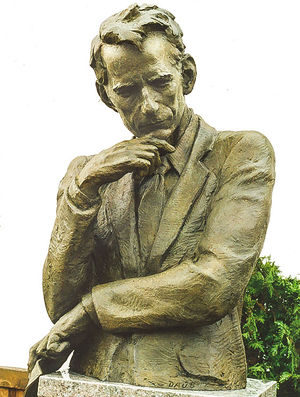Claude Shannon

Claude Shannon (1916-2001) was a theoretical mathematician and electrical engineer who is generally considered to be one of the foundational researchers in computer and communications design. He studied at M.I.T., spent much of his career at Bell Laboratories, and later returned to M.I.T. as a professor. Recognized as a premier voice in the engineering community from the 1940's onward, Shannon had become a figure of some public and popular acclaim by the time of his retirement. An enormous number of resources exist about him on the web, and also in the deep web (i.e., online resources which must be paid for). In his twilight years, Shannon suffered from Alzheimer's disease.
Switching algebra
Shannon made a critical step enabling hardware design of a computer in his 1938 MIT master's thesis, A symbolic analysis of relay and switching circuits[1], in which he associated boolean algebra, a kind of mathematical system that had been known for centuries, with the design of logic gates in digital hardware. Shannon called boolean algebra "switching algebra" in the context of digital hardware design.
Information Theory
The field of information theory was launched in 1948 by Shannon's ground-breaking, two-part paper "A Mathematical Theory of Communication" [2] It was shortly followed by a book [1] which has since been reprinted many times. Information theory is devoted to messages and signals using techniques drawn from mathematical probability, and linking discrete and continuous mathematics in ways that later turned out to be helpful, not just in the fields of communications and computers, but also on thinking about biological processes and linguistics. He was also a pioneer in developing methods for computers to play chess.
Cryptography
During World War II, Shannon performed classified research for the U. S. government on cryptography. His 1949 "Communication Theory of Secrecy Systems"[3] became the seminal paper for cryptography as an academic discipline.
Publications
Papers are shown in order of appearance:
- A symbolic analysis of relay and switching circuits , Thesis (M.S.), Massachusetts Institute of Technology, Dept. of Electrical Engineering, 1937 (graduation finalized in 1940).
- This linked Boolean algebra to the design of digital circuits (and called it "Switching Algebra")
- A Mathematical Theory of Cryptography, Memorandum MM 45-110-02, 1 Sept. 1945, Bell Laboratories. Classified at the time of its publication; now available through the British Library.
- A Mathematical Theory of Communication, Bell System Technical Journal, published in two parts: July, vol. 27, pp. 379-423, and Oct., vol. 28, pp. 623-656, 1948.
- This paper introduced what was later called the Shannon sampling theorem, which described the required frequency needed to sample an analog signal before digitizing it, so that the receiver could perfectly reconstruct the analog signal at the other end of a transmission channel.
- This paper had important implications about the maximum amount of information that could be shoved into a given amount of spectrum before being overwhelmed by noise, a fundamental limit that became known as Shannon's Law.
- This paper coined the use of the word bit.
- Communication Theory of Secrecy Systems, Bell System Technical Journal, vol. 28, pp. 656-715, 1949.
- Communication In The Presence Of Noise, Proceedings of the Institute of Radio Engineers (IRE), vol. 37, pp. 10–21, Jan. 1949.
- This paper extends and elaborates on A Mathematical Theory of Communication
- Reprinted in Proceedings of the IEEE, vol. 72, Issue 9, pp, 1192-1201, Sept. 1984.
- Reprinted in Proceedings of the IEEE, vol. 86, Issue 2, pp. 447-457, Feb. 1998.
- Probability of error for optimal codes in a Gaussian channel, Bell Systems Technical Journal, vol. 38, pp. 611–656, 1959.
Other statue instances
Notes
- ↑ [A symbolic analysis of relay and switching circuits Shannon's Master of Science thesis (online), originally published in Transactions American Institute of Electrical Engineers, Vol. 57, pp. 713-723] (1938). Retrieved on 2020-10-08.
- ↑ A Mathematical Theory of Communication by Claude Shannon, Bell System Technical Journal, July & October, 1948; now on ACM website, last access 10/10/2020
- ↑ C. E. Shannon (1949). Communication Theory of Secrecy Systems.